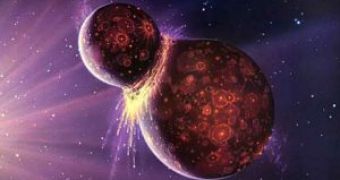Till the discovery of life on Mars, it seems that we are still learning about our closer celestial companion. A new study has found an iron heart for the moon, which pleads to the hypothesis that represents debris thrown off when a big space object collided with a juvenile Earth. "This is the most positive evidence so far that the moon contains a core," said Larry Taylor, director of the Planetary Geosciences Institute at the University of Tennessee in Knoxville. "It's looking more like a planet every day."
"Our moon is too big to be a moon," Taylor said.
"It's huge compared to the moons we see around other planets, so it has always been suspected that there was something strange in its origin."
Most astronomers believe in the "giant impact" theory, which tells about a Mars sized object (half the size of Earth) smashing into a freshly emerged Earth. "This impactor hit, and everything was thrown every which way," Taylor said. "Material was shattered, melted, vaporized, and thrown out into orbit. Some of that material condensed and aggregated into the moon."
Some of the impactor's remains became part of the moon, while the rest was lost in space.
The research team investigated samples of a type of moon rock called mare basalt, brought by early 1970's Apollo missions, which is suspected to have emerged deep in the moon's mantle, being cooled magma.
These dense, dark gray rocks originate from vast, dark, flat lunar areas called mares. These rocks depict a moon mantle very low in elements that bond easily with iron, such as gold and platinum, as in the case of the Earth's mantle, but with even lower levels of those elements. "What happens during the formation of any terrestrial planet is that it undergoes a melting state early in its formation," Taylor said. "In that state you get the separation of metallic iron into a core."
When a planet is forming, the iron-loving elements are largely transferred down into the metallic core, that's why they are scarce in both the Earth's mantle and the moon's. "We must have had a core form [in the moon] to have [iron bonding] elements at the [low] levels we see now," Taylor said. "That's the same thing that happened on Earth, Mars, Venus, and Mercury-the terrestrial planets."
"It could be that the [amount] of these elements in the silicate portion of the impactor and the proto-Earth were quite low at the time of impact, so that when the moon formed, it simply did not contain a high abundance of the elements in question," said Richard Walker, a geologist at the University of Maryland in College Park.
On Earth, the iron core is easy to detect with sensitive seismographs: during earthquakes, the vibrations depict the layers through which they pass. But there are no sufficient seismographs on the Moon to get an accurate view, though moonquakes are common. In the case of the moon, we've never been able to find distinct evidence for [a core], although we've always had our suspicions", said Taylor.
Image credit: NASA

 14 DAY TRIAL //
14 DAY TRIAL //